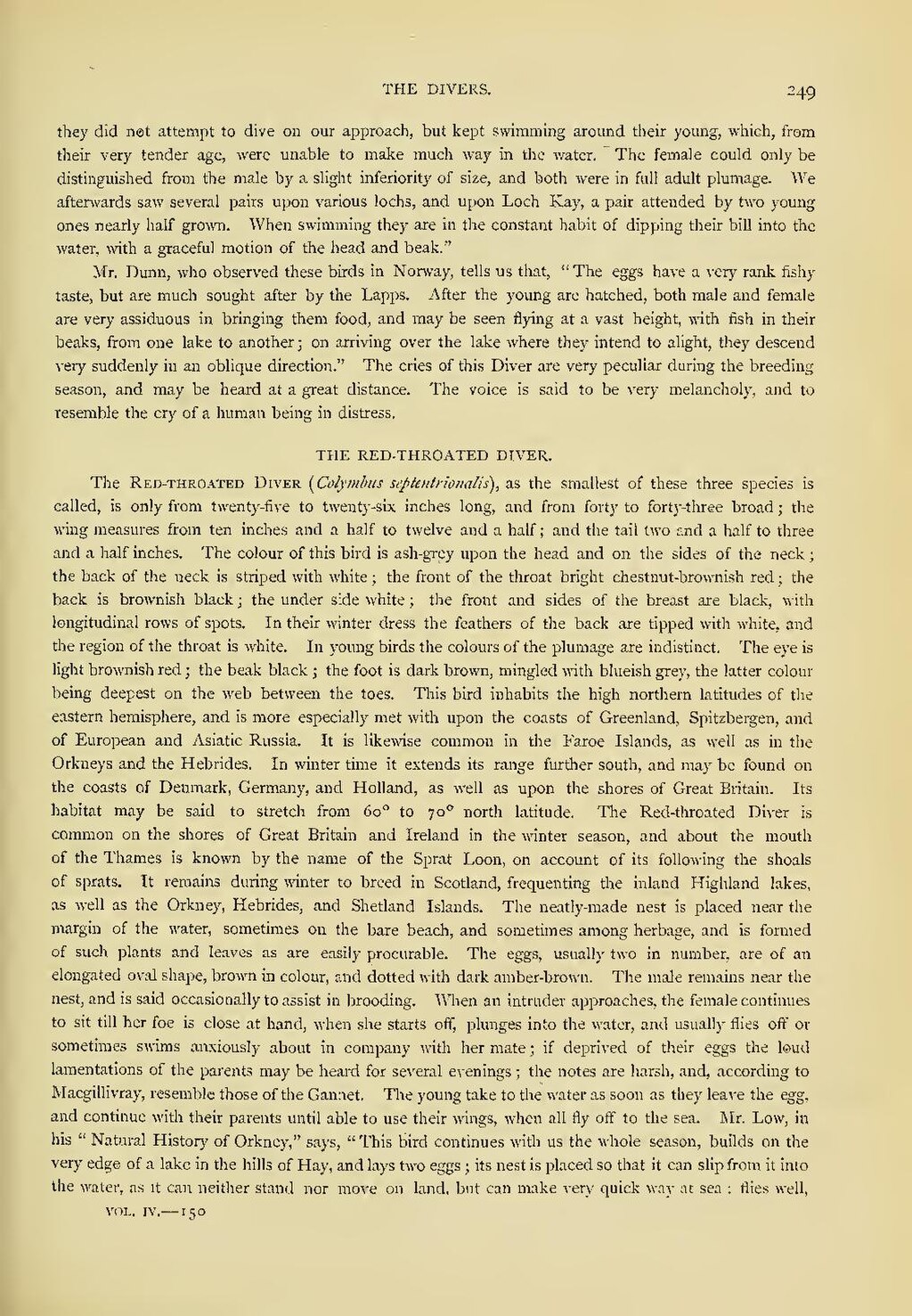they did not attempt to dive on our approach, but kept swimming around their young, which, from their very tender age, were unable to make much way in the water. The female could only be distinguished from the male by a slight inferiority of size, and both were in full adult plumage. We afterwards saw several pairs upon various lochs, and upon Loch Kay, a pair attended by two young ones nearly half grown. When swimming they are in the constant habit of dipping their bill into the water, with a graceful motion of the head and beak."
Mr. Dunn, who observed these birds in Norway, tells us that, "The eggs have a very rank fishy taste, but are much sought after by the Lapps. After the young are hatched, both male and female are very assiduous in bringing them food, and may be seen flying at a vast height, with fish in their beaks, from one lake to another; on arriving over the lake where they intend to alight, they descend very suddenly in an oblique direction." The cries of this Diver are very peculiar during the breeding season, and may be heard at a great distance. The voice is said to be very melancholy, and to resemble the cry of a human being in distress.
THE RED-THROATED DIVER.
The Red-throated Diver (Colymbus septentrionalis), as the smallest of these three species is called, is only from twenty-five to twenty-six inches long, and from forty to forty-three broad; the wing measures from ten inches and a half to twelve and a half; and the tail two and a half to three and a half inches. The colour of this bird is ash-grey upon the head and on the sides of the neck; the back of the neck is striped with white; the front of the throat bright chestnut-brownish red; the back is brownish black; the under side white; the front and sides of the breast are black, with longitudinal rows of spots. In their winter dress the feathers of the back are tipped with white, and the region of the throat is white. In young birds the colours of the plumage are indistinct. The eye is light brownish red; the beak black; the foot is dark brown, mingled with blueish grey, the latter colour being deepest on the web between the toes. This bird inhabits the high northern latitudes of the eastern hemisphere, and is more especially met with upon the coasts of Greenland, Spitzbergen, and of European and Asiatic Russia. It is likewise common in the Faroe Islands, as well as in the Orkneys and the Hebrides. In winter time it extends its range further south, and may be found on the coasts of Denmark, Germany, and Holland, as well as upon the shores of Great Britain. Its habitat may be said to stretch from 60° to 70° north latitude. The Red-throated Diver is common on the shores of Great Britain and Ireland in the winter season, and about the mouth of the Thames is known by the name of the Sprat Loon, on account of its following the shoals of sprats. It remains during winter to breed in Scotland, frequenting the inland Highland lakes, as well as the Orkney, Hebrides, and Shetland Islands. The neatly-made nest is placed near the margin of the water, sometimes on the bare beach, and sometimes among herbage, and is formed of such plants and leaves as are easily procurable. The eggs, usually two in number, are of an elongated oval shape, brown in colour, and dotted with dark amber-brown. The male remains near the nest, and is said occasionally to assist in brooding. When an intruder approaches, the female continues to sit till her foe is close at hand, when she starts off, plunges into the water, and usually flies off or sometimes swims anxiously about in company with her mate; if deprived of their eggs the loud lamentations of the parents may be heard for several evenings; the notes are harsh, and, according to Macgillivray, resemble those of the Gannet. The young take to the water as soon as they leave the egg, and continue with their parents until able to use their wings, when all fly off to the sea. Mr. Low, in his "Natural History of Orkney," says, "This bird continues with us the whole season, builds on the very edge of a lake in the hills of Hay, and lays two eggs; its nest is placed so that it can slip from it into the water, as it can neither stand nor move on land, but can make very quick way at sea; flies well,
